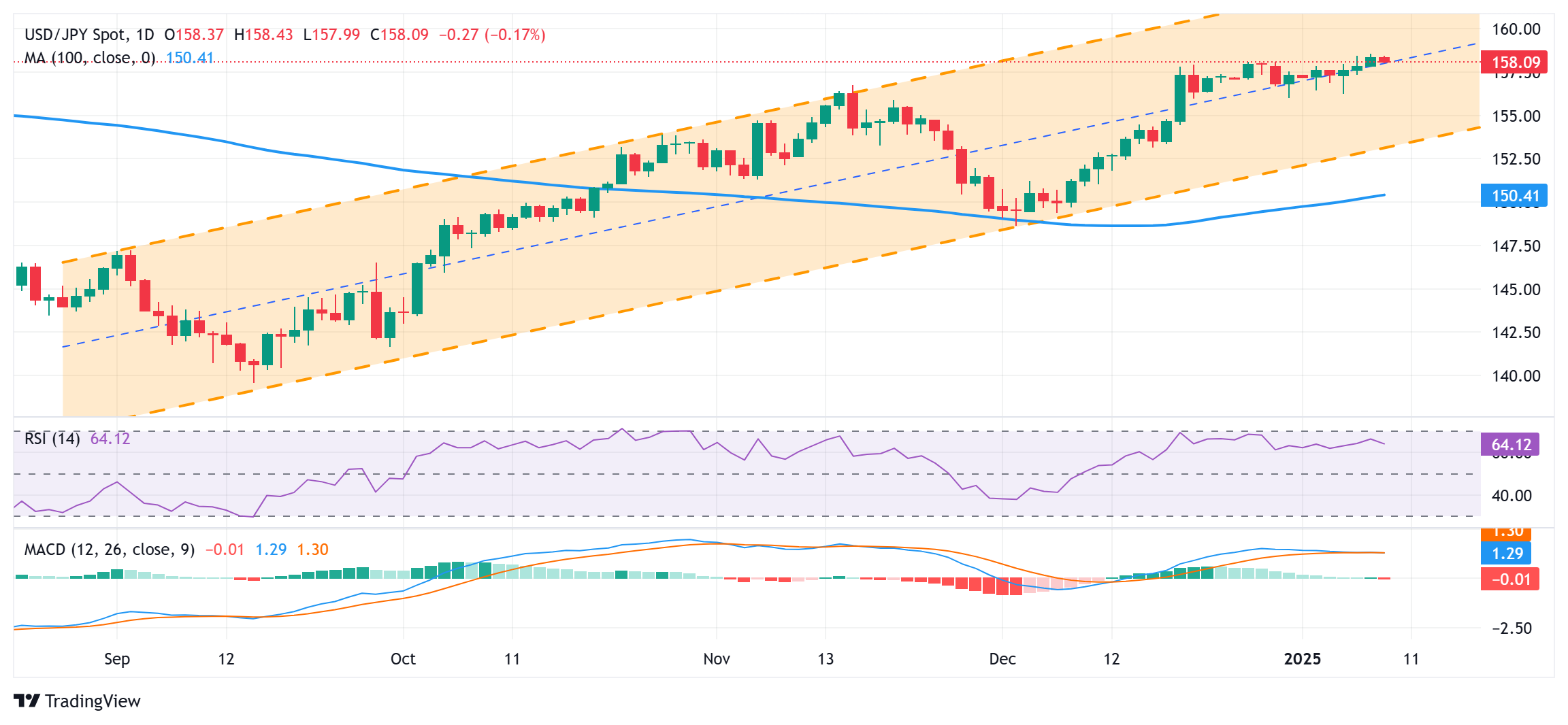Japanese Yen recovers from multi-month low against USD on stronger wage growth data
- The Japanese Yen strengthens in reaction to strong wage growth data from Japan.
- The uncertainty over the likely timing of the next BoJ rate hike might cap the JPY.
- Hawkish Fed, and elevated US bond yields lend some support to the USD/JPY pair.
The Japanese Yen (JPY) ticks higher against its American counterpart after government data showed this Thursday that base pay in Japan grew at the fastest pace in more than three decades. This comes on top of talks that large Japanese firms are likely to increase wages by about 5% on average in 2025, which, along with broadening inflationary pressure, backs the case for another interest rate hike by the Bank of Japan (BoJ). Apart from this, the cautious market mood underpins the safe-haven JPY and drags the USD/JPY pair away from a multi-month peak, around the 158.55 region touched on Wednesday.
Investors, however, remain skeptical about the likely timing of when the BoJ will hike interest rates again and expect the central bank to wait until this year's Shunto spring labor-management negotiations. Furthermore, the recent widening of the US-Japan rate differential, bolstered by the Federal Reserve's (Fed) hawkish signal that it would slow the pace of rate cuts in 2025, might contribute to capping the lower-yielding JPY. Traders might also opt to wait on the sidelines ahead of speeches by a slew of influential FOMC members later this Thursday and the US Nonfarm Payrolls (NFP) report on Friday.
Japanese Yen draws support from a rise in Japan’s base salaries by the fastest pace in 32 years
- Government data released this Thursday showed that base salary, or regular pay, in Japan rose 2.7% in November, marking the fastest increase since 1992, while overtime pay grew 1.6% from a revised 0.7% gain in October.
- Meanwhile, inflation-adjusted real wages fell for the fourth consecutive month, by 0.3% in November. The inflation rate the ministry uses for wage calculation accelerated from 2.6% in October to 3.4% from a year earlier.
- The Bank of Japan has repeatedly said sustained, broad-based wage hikes are a prerequisite for pushing up borrowing costs and the data support prospects for a further rate hike, providing a modest lift to the Japanese Yen.
- Investors, however, seem convinced that the BoJ will not pull the trigger at its next monetary policy meeting in January and wait until March amid the uncertainty over US President-elect Donald Trump's protectionist policies.
- CNN reported on Wednesday, citing unnamed sources familiar with the matter, that Trump is considering declaring a national economic emergency to provide legal justification for a series of universal tariffs on allies and adversaries.
- The yield on the benchmark 10-year US government bond shot to its highest level since April 25 in reaction to the news, which, to a larger extent, overshadowed mixed labor market data released from the US on Wednesday.
- The Automatic Data Processing (ADP) reported that US private sector employment rose by 122,000 in December as compared to the 146,000 increase recorded in November and below the market expectation of 140,000.
- Separately, the US Department of Labor reported that the number of Americans filing new applications for unemployment benefits fell to an 11-month low of 201K in the week ending January 4, pointing to a stable labor market.
- Furthermore, the Minutes of the December 17-18 FOMC meeting revealed that policymakers were in favor of slowing the pace of rate cuts amid concerns about slower progress on curbing the pace of inflation toward the 2% target.
- Fed Governor Christopher Waller said that inflation should continue to fall and make further progress towards the 2% target, which should allow the US central bank to further reduce interest rates, though at an uncertain pace.
- Investors will continue to take cues from speeches by a slew of influential FOMC members later this Thursday, though the focus will remain glued to the closely-watched US Nonfarm Payrolls (NFP) report on Friday.
USD/JPY is likely to attract some dip-buyers and find decent support near the 157.55-157.50 area

From a technical perspective, any subsequent slide is likely to attract some dip-buying near the 157.55-157.50 horizontal zone. Some follow-through selling, however, could make the USD/JPY pair vulnerable to accelerate the fall further towards the 157.00 mark en route to the next relevant support near the 156.75 region and the weekly low, around the 156.25-156.20 area. This is followed by the 156.00 mark, which if broken decisively might shift the bias in favor of bearish traders.
On the flip side, the 158.55 region, or the multi-month top touched on Wednesday, now seems to act as an immediate hurdle. A sustained strength beyond could lift the USD/JPY pair to the 159.00 mark. The momentum could extend further towards the 159.45 intermediate hurdle before spot prices aim to reclaim the 160.00 psychological mark.
Economic Indicator
Labor Cash Earnings (YoY)
This indicator, released by the Ministry of Health, Labor and Welfare, shows the average income, before taxes, per regular employee. It includes overtime pay and bonuses but it doesn't take into account earnings from holding financial assets nor capital gains. Higher income puts upward pressures on consumption, and is inflationary for the Japanese economy. Generally, a higher-than-expected reading is bullish for the Japanese Yen (JPY), while a below-the-market consensus result is bearish.
Read more.Last release: Wed Jan 08, 2025 23:30
Frequency: Monthly
Actual: 3%
Consensus: 2.7%
Previous: 2.6%
Source: Ministry of Economy, Trade and Industry of Japan

